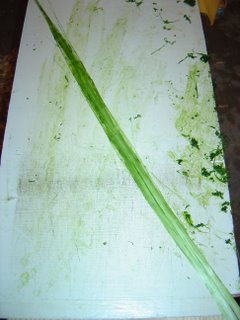- Abundant - it is a common landscaping plant. I can drive down the street an see it in many yards.
- Long leaves - Long leaves means long fibers which means less splicing when making cordage.
- Strong - Yucca is one of a few plants that is supposed to be strong enough to make a small diameter bowstring.

The process to go from leaf to rope is actually relatively quick. I was able to process one leaf in about 10 minutes. I can probably be done even quicker. To make things faster, you could do less scraping, but the final product might not be as strong. In particular, if the diameter of the rope you are making is going to be big, you can leave more green on, and not break up the strands so small. When I made the necklace cord in my last post, I broke up the strands a lot since I wanted it to be finer quality.
Leaf after being pounded with a block of wood.

Leaf after being scraped with the back of a knife.

Here is the leaf after being fully scraped.

Yucca fibers after pulling the above leaf apart.

An example of how to make cordage from the fibers.

As you run out of fiber, you can easily splice in new fibers. The piece seen above is using all the fibers from one of the smaller length leaves I have. The diameter of the rope is about 1/4 inch. When I made the necklace cord, I used about half of a large leaf. I'm thinking about making a bowstring with some of the fibers. Whatever happens, I'll post what my finished product is.

5 comments:
what other common plants can one use?
thistles will work too although not as strong.
In my area (Washington) I use the fibers from dried nettle stalks, which are the strongest in out are, as well as the inner bark of ceder.
Very Nice post, good job!
Some other plants you can use are blackberry, milkweed, and the inner bark of some vines. I think thistles are pretty brittle though for making cordage.
I am going to try your method today!
~Wa-ya
Kudzu bark makes good rope. pretty abundant here in Alabama.
Post a Comment